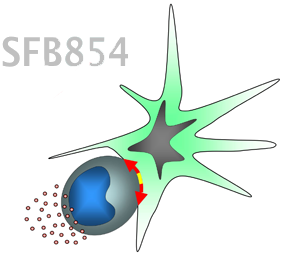After a successful start in 2016, in 2017 the Health Campus Immunology, Infectiology and Inflammation (GC-I³) again invited its members to submit publications for the Paper of the Year. The best three were chosen from the ten submissions, which had an average impact factor of 11.1. Two of them, namely the first and third prize-winning articles, originate from projects of the SFB 854.
Dr. Kerry Tedford from the Institute for Biochemistry and Cellular Biology received the first price for her work „The opposing forces of shear flow and sphingosine-1-phosphate control marginal zone B cell shuttling“, which was published in Nature Communications. Marginal zone B cells are specialized B cells in the spleen; they are an important part of the early immune response against pathogens in the blood. In order to optimally complete their task, they must move between different regions within the spleen. In her paper, Dr. Tedford showed for the first time that the B cells use the direction and velocity of the blood flow as orientation. In addition, it is known that sphingosine-1-phospate (S1P) plays a role in this process, but the researchers demonstrated for the first time a molecular mechanism that explains the role of S1P. This is especially significant because signalling pathways enabled by S1P are the goal of important therapeutics, for example against the autoimmune disease multiple sclerosis.





